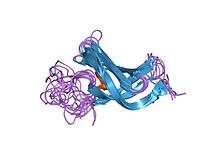Cold-shock domain
| CSD | |||||||||
|---|---|---|---|---|---|---|---|---|---|
 solution structure of the single-stranded dna-binding cold shock domain (csd) of human y-box protein 1 (yb1) determined by nmr (10 lowest energy structures) | |||||||||
| Identifiers | |||||||||
| Symbol | CSD | ||||||||
| Pfam | PF00313 | ||||||||
| Pfam clan | CL0021 | ||||||||
| InterPro | IPR002059 | ||||||||
| PROSITE | PDOC00304 | ||||||||
| SCOP | 1mjc | ||||||||
| SUPERFAMILY | 1mjc | ||||||||
| CDD | cd04458 | ||||||||
| |||||||||
In molecular biology, the cold-shock domain (CSD) is a protein domain of about 70 amino acids which has been found in prokaryotic and eukaryotic DNA-binding proteins.[1][2][3] Part of this domain is highly similar to the RNP-1 RNA-binding motif.[4]
When Escherichia coli is exposed to a temperature drop from 37 to 10 degrees Celsius, a 4-5 hour lag phase occurs, after which growth is resumed at a reduced rate.[5] During the lag phase, the expression of around 13 proteins, which contain cold shock domains is increased 2-10 fold.[6] These so-called 'cold shock' proteins are thought to help the cell to survive in temperatures lower than optimum growth temperature, by contrast with heat shock proteins, which help the cell to survive in temperatures greater than the optimum, possibly by condensation of the chromosome and organisation of the prokaryotic nucleoid.[5]
References
- ↑ Doniger J, Landsman D, Gonda MA, Wistow G (April 1992). "The product of unr, the highly conserved gene upstream of N-ras, contains multiple repeats similar to the cold-shock domain (CSD), a putative DNA-binding motif". New Biol. 4 (4): 389–95. PMID 1622933.
- ↑ Wistow G (April 1990). "Cold shock and DNA binding". Nature 344 (6269): 823–4. doi:10.1038/344823c0. PMID 2184368.
- ↑ Jones PG, Inouye M (March 1994). "The cold-shock response--a hot topic". Mol. Microbiol. 11 (5): 811–8. doi:10.1111/j.1365-2958.1994.tb00359.x. PMID 8022259.
- ↑ Landsman D (June 1992). "RNP-1, an RNA-binding motif is conserved in the DNA-binding cold shock domain". Nucleic Acids Res. 20 (11): 2861–4. doi:10.1093/nar/20.11.2861. PMC 336933. PMID 1614871.
- 1 2 Obokata J, Ohme M, Hayashida N (October 1991). "Nucleotide sequence of a cDNA clone encoding a putative glycine-rich protein of 19.7 kDa in Nicotiana sylvestris". Plant Mol. Biol. 17 (4): 953–5. doi:10.1007/bf00037080. PMID 1912512.
- ↑ Tafuri SR, Wolffe AP (November 1990). "Xenopus Y-box transcription factors: molecular cloning, functional analysis and developmental regulation". Proc. Natl. Acad. Sci. U.S.A. 87 (22): 9028–32. doi:10.1073/pnas.87.22.9028. PMC 55094. PMID 2247479.
This article incorporates text from the public domain Pfam and InterPro IPR002059